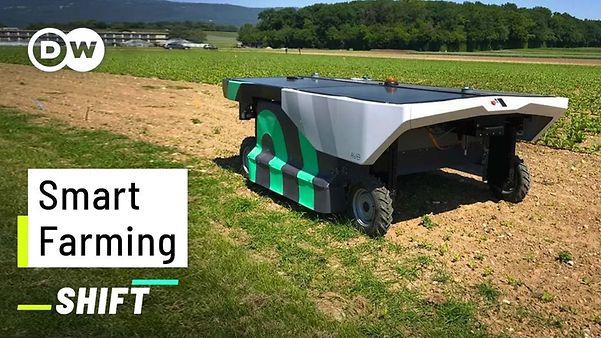Smart Farming: How 5G Powers Digitization of Agriculture
5G enables autonomous field robots, self-driving tractors and camera drones to help transform agriculture into a theater of smart farming technologies.
Plowing large fields is monotonous work. The farmer spends hours in the cabin of his tractor as the plow tears open the topsoil behind him. He drives one line after another, to and fro, as precisely as possible, from morning to evening for as long as he can still see his track markings in the twilight. Digital technologies could relieve him of this onerous work in the future.

In brief
- 5G is the driving force behind smart farming and autonomous agriculture: the technology enables the use of autonomous field robots, self-driving tractors, and camera drones that work with precision, save farmers time, and counteract the shortage of skilled workers.
- Increased efficiency and resource conservation through digital solutions: Using 5G-connected sensors, AI-supported image recognition, and precise GPS positioning, farmers can significantly reduce the use of fertilizers and pesticides, leading to cost savings and more sustainable production.
- 5G improves maintenance and support for complex agricultural machinery: Fast and stable 5G connections enable augmented reality applications and mobile, cloud-based assistance systems to be used for remote diagnosis and repair of agricultural machinery, minimizing downtime and increasing efficiency.
Fully Autonomous Tractor From Las Vegas
At the Consumer Electronics Show (CES) in Las Vegas the agricultural technology heavyweight John Deere unveiled its first large-scale production-ready autonomous tractor. The U.S. manufacturer has equipped its 8R tractor with a remote-controllable steering system and six stereo cameras. The cameras keep an eye on the ground around the tractor and identify larger obstacles in the field. The tractor stays on track to within two or three centimeters thanks to GPS and mobile radiolocation.
If he wants to, the farmer can follow the action live by using a smartphone app to watch the cameras’ video stream. He can also use the app to stop and start the tractor. He can even adjust the speed and depth of plowing remotely. The 8R solves several problems at the same time. It plows more precisely than a human, frees up the farmer for other tasks and is also a possible solution to the shortage of skilled farm workers.
Definition | What Is Smart Farming?
Experts define Smart Farming as the digitization of agriculture. In literature on the subject the terms Agriculture 4.0 or Farm 4.0, Smart Agriculture or E-Farming, Digital Farming and Precision Farming are also often used. These concepts refer to using digital technologies and devices such as field robots to make the farmer’s work more efficient, more productive and/or more sustainable.
Drones: Smart Helpers in the Air
Driverless farm machinery is only one innovation made possible by the digitization of agriculture, also known as smart farming (see definition). With sensor technology and the Internet of Things (IoT), for example, just about everything in agriculture can be recorded. A drone with sensors makes recording mobile to the max. Autonomously or remote-controlled, drones can take the place of manual farm labor and in addition bring new findings for the future.
Eastern Switzerland University of Applied Sciences (OST), for example, is using drones in a pilot project to photograph dock plants in a field, dock being an undesirable plant that displaces crop plants. A wireless module in the drone relays the digital image data to the Cloud via the 5G cellular network for real-time analysis. Artificial intelligence (AI) then kicks in. Software with self-learning algorithms identifies the harmful plant and sends this information back to the field, where an agricultural robot is navigated by GPS to the unloved dock plant and targets it with a herbicide. According to the OST this method reduces the use of herbicide by up to 90 percent. The experts are also considering the use of hot water instead of herbicide in the future.
„Die Entwicklungen in der Bilderkennung und im autonomen Fahren, an denen wir arbeiten, sind nur mit einer ausgebauten 5G-Infrastruktur machbar.“
Dejan Seatovic, Professor im Studiengang Maschinentechnik und Innovation an der OST
In a poll of agricultural enterprises in Germany PwC management consultants have identified the pinpointed use of fertilizer as an application with the greatest savings potential. Site-specific fertilization in particular, which takes into account growth and soil differences within a field, can be made more efficient by means of digital technologies. Drones equipped with multispectral cameras or robot vehicles that register light in the near infrared range can for example establish the growth and nitrogen requirement of crop plants or measure soil humidity and temperature. With these measurements at their disposal farmers can pinpoint their fertilization and irrigation and thereby save valuable resources.
Similar use case or any questions?
Simply fill out the contact form – we’ll get back to you as soon as possible.
Artificial Intelligence
The Agri-Gaia Project, a decentrally organized infrastructure for sharing data and algorithms in agriculture, shows that AI will play an important role in farming in the future. A consortium of industry and research is working on the realization of an open AI standard for the farming and food industry. Agri-Gaia aims to bring users and developers of AI algorithms together on a manufacturer-independent platform to share data and algorithms. The project uses the GAIA-X sovereign European data infrastructure.
Augmented Reality for Swift Assistance
5G cellular technology, which is now available almost everywhere in rural areas (see Infobox), ensures swift and reliable transmission even of large amounts of image and video data. In the future 5G will also help farmers when they have problems with their machines. The INVIA project of the Fraunhofer Institute for Cognitive Systems (ICS) is working on a mobile, cloud-assisted assistance system for diagnosing and servicing complex agricultural machinery. If a tractor or harvester breaks down the driver contacts the manufacturer’s customer service, which helps to identify the fault by means of audio, image and video. If a callout is required, the technician will then arrive with the right tools and spare part. Wearing augmented reality (AR) glasses the technician can even be guided through the repair on-site by an expert at his service desk. Thanks to a swift and stable 5G connection all these steps go ahead smoothly and successfully.
Plowing, sowing, harvesting and getting rid of weeds in the field require precision, and here too 5G comes into its own, especially for autonomous harvesters, seed drones, tractors and field robots that are designed to take the physical labor aspect of hard work out of farming. They need the most exact Web description of their way around the field. The German startup AI.Land and Aachen University of Applied Sciences have developed an autonomous robot that is designed to automate monotonous and physically demanding work in the field. The robot stays on track thanks to precise positioning.
Precise Tracking Thanks to Gps and 5G
The localization precision of GPS is optimally to between three and five meters, which is much too inaccurate for plowing topsoil in a field. Precise Positioning, a solution developed by Deutsche Telekom and the U.S. navigation specialist Swift, is precise to within ten centimeters. How does it do it? Special antennas (Germany already has a nationwide network in place) collect GPS signals from 40 to 50 GNSS (Global Navigation Satellite System) satellites. From this data and the exact stationary data from the antennas a Swift cloud algorithm calculates corrected high-precision position data and relays it in real time via the G5 cellular network to vehicles, drones and autonomous machines. This innovative technology helps AI-Land’s farm robot to stay precisely on track – and to relieve farm workers of what is otherwise not the most pleasant work.
Pluck and plant robots, autonomous irrigation vehicles, cows with fitness trackers, geofenced goats and drones that spread wasp larvae over the field or combat harmful insects – this Deutsche Welle video (12:30 min) shows the range of digital technologies that are now used in farming:
Smart Farming


Ümit Günes
Marketing Manager IoT
Having been with Telekom since 2008, Ümit possesses a comprehensive understanding of various facets of the Internet of Things. He has a keen interest in the digital transformation of the business world. On this blog, he shares insights into the latest developments and trends in the IoT sector that provide genuine value to customers.